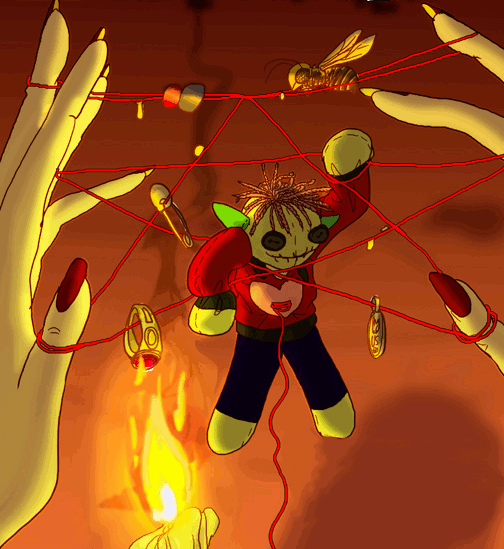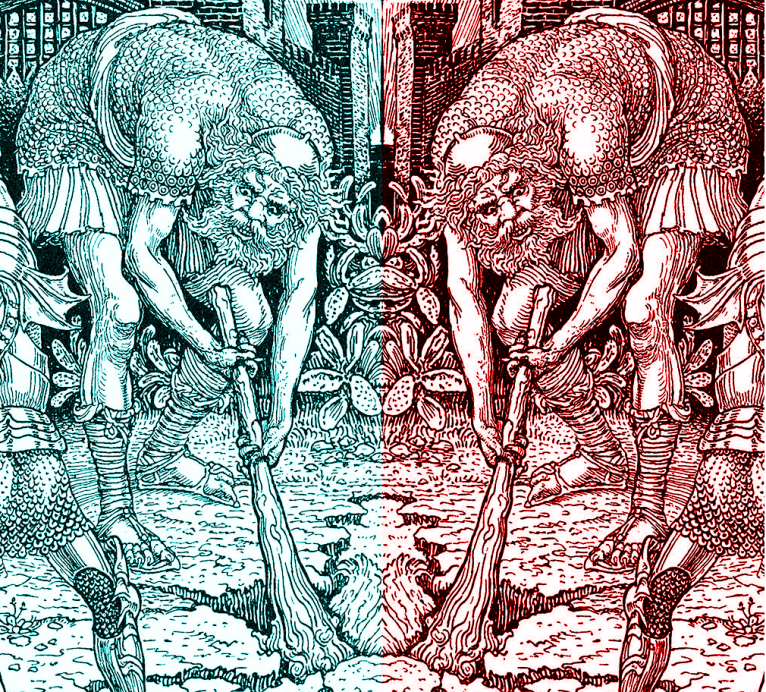The following was a portion of the RPG based on our original comic, Skeleton Crew, that’s currently on the back-burner. In the meantime, I thought I’d share this section you on how to make your adventures a little more terrifying.
Unknown Threat
It’s easy to think of a dozen different types of monsters out there (ghouls, ghosts, vampires, etc.), but you have to remember—tales of monsters existed centuries before monsters had any names. It is common for gamers to label creatures into neat little categories—but to name something is to understand it, and the root of suspense comes from NOT knowing. When writing a creepy adventure, it might pay off to create a horror of your own. You might hint at the name through a local legend, but leave only vague stories as to what it could really be. In terms of skills and aspects, it might resemble other monsters, but the players will no idea how strange or tough the creature they are facing is. Or, make them think they know what it is, until you decide to switch it up on them—have them encounter a normal vampire, only to have his head sprout crab legs and walk off of his shoulders.
Naming Your Monsters (English and American)
Personally, I think folksy or childish sounding names often have the creepiest feel—better still if they have onomatopoeia in them. For example, why not the Tailypo, the Snickercatch, the Moggytom, the Nibblegnaw, the Cindergrim? Author Neil Gaiman wrote an amazing short ghost story called “Click Clack the Rattlebag”…little is known about the “Click Clack” monster, except it drinks the victim’s insides, leaving only a clattering “Rattlebag” of skin and bones. Brrr!
Nursery rhymes work great in there, too. Think of nonsense/old words like “eeny” and “winkum”, find a good meter, and add in some vaguely creepy stuff to the verse.
Ragged-Man
Ten little fingers, nine little toes
Ragged Man comes, and the Ragged Man goes
Eight little fingers, little toes seven
Keeps you from hell and he keeps you from heaven
Six little fingers, little toes five
Ragged Man steals you, a bit at a time.
Four little fingers, three little hairs
Ragged Man’s coming, up up the stairs
Two little eyes, and one little thumb
Nothing can help you, the Ragged Man’s come!
Naming Your Monster (Bilingual Version)
Of course, the above works best with English speaking threats—for exotic creatures, go with exotic names. Look up local monsters, and mash them around—the Indian Vyala becomes a Vylkara. Or, use an internet translator, and keep translating random dark words until you have a name that sounds neat. For example, Babelfish.com says “death forest” in German translates into “Tod-Wald”… not a bad creature name for 3 seconds of research.
Creating Monsters—Letting the Players Do the Work
There’s no reason that you can’t force your players to do the hard work for you. Don’t have a name for them? Let the characters come up with a nickname all their own—this helps if you give the creature a very distinct appearance—Example: , spiders for hands, three red eyes, etc. You probably won’t need to ask them—by the second time they see them, the characters will probably start tossing names around themselves as they communicate. Likewise, if they have a Mythos-heavy character in the group, he or she might declare that he or she has heard some of the legends concerning the creature, and come up with a neat new aspect to include in the origin story. An example of this shows up in the movie The World’s End, which features the heroes desperately trying to name the eerie villains—they use “the blanks” as a placeholder while the argue over the perfect name. Only then do they realize that “the Blanks” IS the perfect name for them!
Apparent Danger
Many of your adventures, humorous or horrifying, might start off the same way. However, once secondary characters start dropping dead or your group uncovers mass graves, the mood will change quite quickly. You have to get the players into the frame of mind that their characters are in legitimate danger—someone or something is here, just out of sight, and is fully capable of picking them off one by one. A few NPCs can be sacrificed to get this mood across—likewise, if the NPC Ranger Bob was the only with knowledge of the mountain (and with keys to the truck), your safe one-hour drive just became a 6 hour game of survival in the dark woods. Also, don’t be afraid to ignore dice and stats and tease the group with an impossible threat—maybe they can’t hurt the Moggytom during its first encounter, but learning its secret will allow them to physically hurt it. A helpless group will be more likely to fear the threat. If your group is a little virtuous, leave them a living NPC alive that they have to escort out—his vulnerability becomes THEIR vulnerability.
Get Gruesome
Not advised for queasy groups, but rather than just having NPCs disappear, have them be found again—in a barely recognizable state. Give them bloody scenes, slashed corpses, and guts galore. If you want to make it dark and still confusing, maybe the only way to know the number of victims is, (to quote the They Might Be Giants song), to “count the arms, the legs and heads, and then divide by five.” The primary function of such gruesomeness is to make the characters realize that danger can befall themselves (or the few remaining NPCs under their protection.) Secondly, any patterns might lead your characters to the origin of the monster—if all the victims are impaled with ancient railroad spikes, maybe researching into the old, abandoned railroad line will reveal a horrible tragedy left unavenged. Thirdly, if you like a bit of mystery, maybe you can hide the real threat amongst the victims—at first, it seems that all five of the grad students were liquefied in the dorm room, but close analysis shows that only four died in that mess. Was the killer hiding amongst you the whole time?
For further
Evil = Intelligence
All great monsters, but especially werewolves, focus on the idea that a normal human can be turned into a beast. Underneath our suits and ties, each of us has a hungry animal, waiting to lose control. This is a common trend, and will (and probably should) show up during your campaign. However, nowadays, we occasionally see traditional monsters as civil and intelligent—our zombies eat pizza, our vampires read the paper and only drink animal blood, etc. However, if you want to add a creepy twist, introduce a former-human-turned-monster that’s in control and yet still a man-eater—a civil, reasoning monster that does unspeakable things. For example, Jonathan Coulton wrote the song, “Re: Your Brains,” about a group of humans barricaded in a mall. One of the attacking zombies (and the singer of the song) is a former coworker turned brain-eater, trying to convince them to surrender. On the surface, it’s hilarious—a zombie is throwing around business buzz-words like “FYI” and “table it for now.” When you analyze it, though, it features a zombie that remembers his previous life, can empathize with the survivors, but still feels NO REMORSE for trying to bash their skulls open and devour them. That’s all kinds of sick.
Ticking Clock
A convention of suspense that easily carries over into horror. Make the heroes race a proverbial clock—if they fail to do something by a certain time, something horrendous will happen. This is common enough in most stories already, but the way to make it clearer still to the group is to have an actual escalation—a bogey that feeds in the darkness is creepy. Why not have the rain start coming in, along with clouds that darken the moon? Worse still, the city blocks are suffering blackouts, one after the other, getting closer and closer still…This can also be done with aspects—maybe they are each given a negative aspect representing a strange mental influence, such as On Edge, and when you get really close to the climax, replace it with more and more sinister aspects, such as Violent Rage, or Murderous Instincts—suddenly, they are not their own masters, and they have only a short time before their humanity is lost!
Further Reading
One last recommendation: for further reading, I recommend Steven King’s “Three Categories of Terror“.
That’s it for now… Until next time, Game On!
-Dave Seidman-Joria










 A wizened human nursemaid, who watches her adult charge like a mother bear. A tiefling butler who carries out his master’s wishes with much alacrity and little morals. A nimble halfling gardener whose courage far surpasses his size.
A wizened human nursemaid, who watches her adult charge like a mother bear. A tiefling butler who carries out his master’s wishes with much alacrity and little morals. A nimble halfling gardener whose courage far surpasses his size.





 Creators: Writer: Rob Wieland. Editor: Joshua Yearsley. Art: Brian Patterson.
Creators: Writer: Rob Wieland. Editor: Joshua Yearsley. Art: Brian Patterson.
